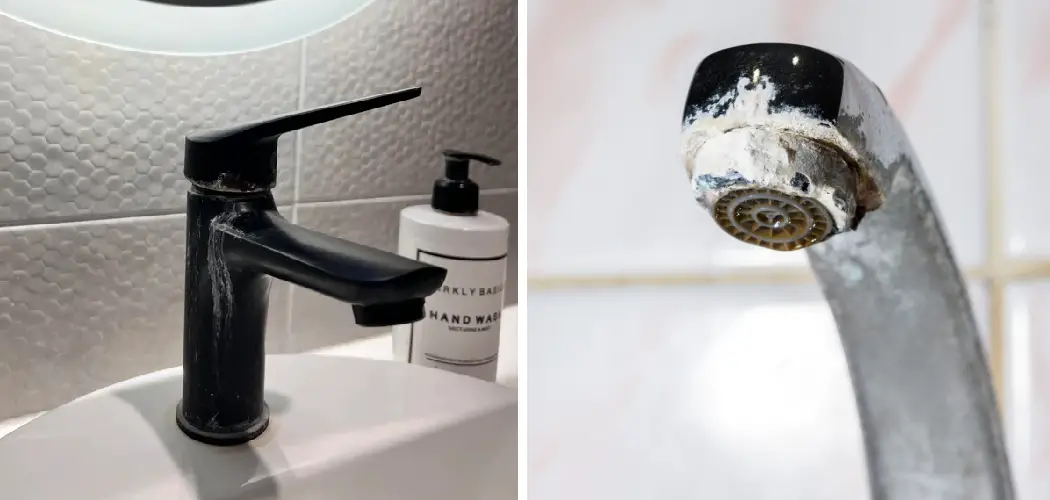Limescale is a hard, chalky deposit primarily composed of calcium carbonate. It commonly accumulates in areas with hard water, where high levels of dissolved minerals are present. This unsightly residue often builds up on faucets, leaving them dull and less efficient. Understanding how to get rid of limescale on faucet is vital for maintaining both the appearance and functionality of your fixtures.
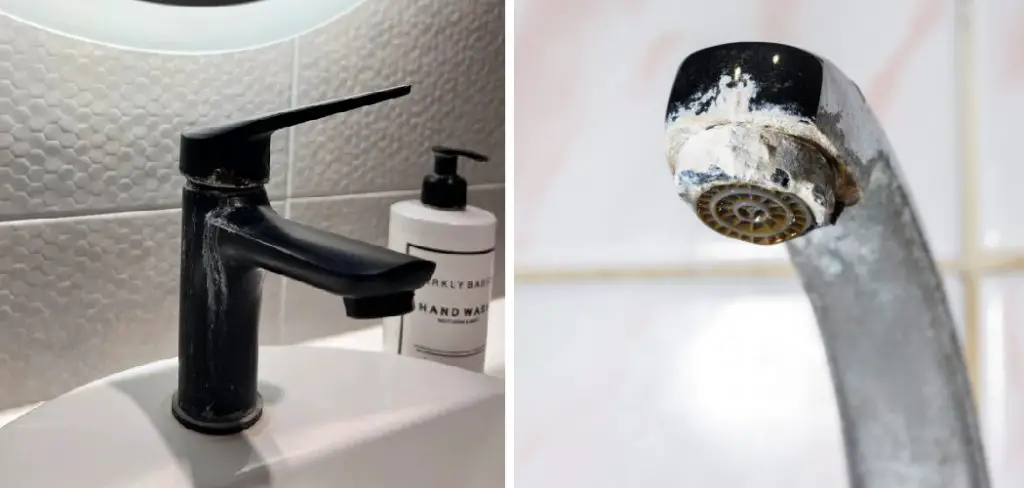
Removing limescale can prevent potential damage that may hinder water flow and affect the longevity of your faucet. There are various methods to effectively tackle limescale buildup, ranging from natural solutions like vinegar and lemon juice to commercial descaling products. Each of these approaches offers a different way of dealing with stubborn deposits, ensuring you can find a solution that works best for your needs.
Gather Supplies
Before you begin removing limescale from your faucet, it’s essential to gather all the necessary supplies. Depending on your preference, you can choose between natural or commercial cleaning solutions.
Natural Cleaning Solutions
- White Vinegar: An effective and eco-friendly option for dissolving limescale.
- Lemon Juice: Known for its acidic properties, it can help break down mineral deposits.
- Baking Soda: Often used in combination with vinegar or lemon juice to enhance cleaning power.
Commercial Cleaners
- Limescale Remover: Specially formulated to tackle stubborn limescale deposits.
- CLR (Calcium, Lime, Rust Remover): A powerful product that targets multiple types of mineral buildup.
Tools
- Soft Cloths: These are used to wipe down the faucet and apply cleaning solutions.
- Old Toothbrush: To scrub away limescale in hard-to-reach areas.
- Plastic Bag: Useful for soaking the faucet in the cleaning solution.
- Rubber Bands: To secure the plastic bag around the faucet.
- Gloves: To protect your hands from harsh chemicals or prolonged exposure to acidic solutions.
- Sponge: For additional scrubbing and cleaning.
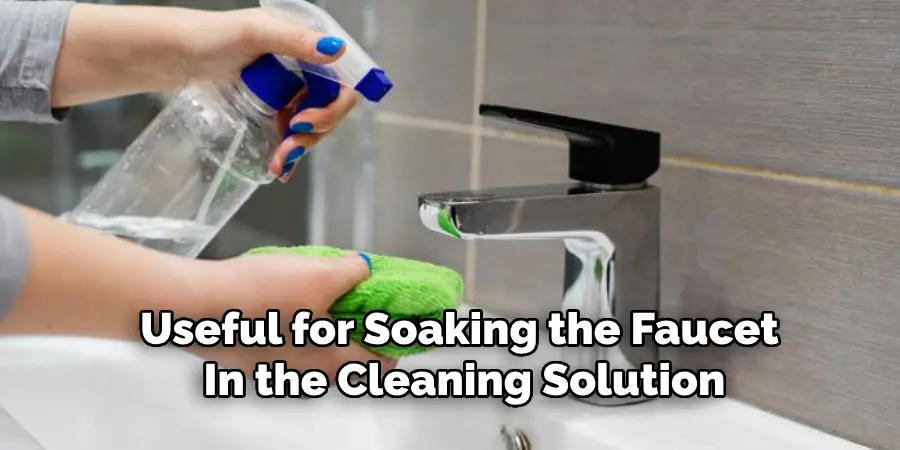
How to Get Rid of Limescale on Faucet: Natural Cleaning Method
1. Vinegar Soak
Prepare the Vinegar Solution
Mix equal parts of white vinegar and water. This solution is both effective in dissolving limescale and eco-friendly.
Soak the Faucet Aerator
- If possible, remove the aerator and soak it in the vinegar solution for about an hour. This will help dissolve the calcium carbonate deposits effectively.
- If the aerator cannot be removed, soak a cloth in the vinegar solution and wrap it around the affected area. Ensure the cloth is fully saturated with the solution to get the best results.
Plastic Bag Method
- Fill a plastic bag with the vinegar solution. This method is ideal for targeting the limescale buildup on the spout.
- Secure the bag around the faucet spout with a rubber band, ensuring the limescale-covered areas are submerged.
- Leave it in place for at least an hour. You may want to leave it longer for severe buildup to ensure the deposits soften sufficiently.
Scrub and Rinse
- After soaking, use an old toothbrush to scrub away the loosened limescale. The vinegar’s acid will have softened the deposits, making them easier to remove.
- Rinse thoroughly with warm water and wipe dry with a soft cloth to prevent water spots and ensure a gleaming finish.
2. Lemon Juice Application
Apply Lemon Juice
- Cut a lemon in half and rub it directly onto the limescale deposits. The lemon’s natural acidity works similarly to vinegar in breaking down the mineral buildup.
- Alternatively, soak a cloth in lemon juice and wrap it around the affected areas for a more controlled application, especially if dealing with hard-to-reach spots.
Let It Sit
Allow the lemon juice to sit for at least 30 minutes. This waiting period is crucial for the acid to penetrate and break down the tough limescale deposits.
Scrub and Rinse
- After the lemon juice has done its job, scrub the area with an old toothbrush to remove the loosened limescale.
- Rinse with warm water and wipe dry with a soft cloth. The lemon’s fresh citrus scent will also leave your faucet smelling clean.
3. Baking Soda Paste
Make the Paste
Mix baking soda with a small amount of water to form a paste. The mildly abrasive nature of baking soda makes it effective for scrubbing off stubborn limescale without scratching the surface of your faucet.
Apply the Paste
Apply the baking soda paste to the limescale-affected areas. Ensure you cover all the deposits for thorough cleaning.
Scrub and Rinse
- Let the paste sit for 15-20 minutes. This allows the baking soda to work on the deposits.
- Scrub the area with an old toothbrush, focusing on the toughest spots.
- Rinse with warm water and wipe dry with a soft cloth. The result is a shiny, limescale-free faucet.
Using these natural cleaning methods not only effectively gets rid of limescale but also ensures that you are using safe, non-toxic ingredients that are kind to the environment.
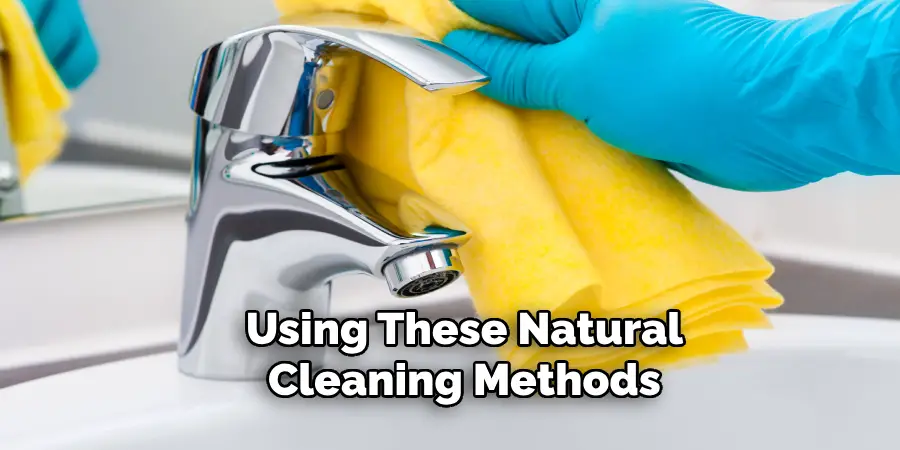
How to Get Rid of Limescale on Faucet: Commercial Cleaning Products
1. Choose a Product
Select a commercial limescale remover that suits your needs. Popular options include limescale removers specifically formulated for faucets or products like CLR (Calcium, Lime, Rust remover). Both are effective at tackling stubborn limescale deposits and can save time compared to natural methods.
2. Apply According to Instructions
Follow the Manufacturer’s Instructions
Once you have your chosen limescale remover, read the manufacturer’s instructions carefully. Each product may have specific guidelines to ensure optimal results and safety. Typically, the application involves:
- Applying the cleaner directly to the affected areas. Be sure to cover all visible limescale deposits.
- Allow the cleaner to sit for the recommended time, usually several minutes to a half-hour. This soaking period is crucial for the product to break down the mineral deposits effectively.
3. Scrub and Rinse
Scrub with a Toothbrush or Sponge
After the soaking period, use an old toothbrush or sponge to scrub the loosened limescale. The product’s active ingredients will penetrate and soften the deposits, making them easier to remove. Focus on any remaining tough spots, applying additional cleaner if necessary.
Rinse Thoroughly with Warm Water
Once you have scrubbed away the limescale, rinse the area thoroughly with warm water. This step removes any residual cleaner and limescale particles.
Wipe Dry
Finally, wipe the faucet dry with a soft cloth to prevent water spots and maintain its shine. Regular use of commercial cleaners can keep your faucet looking and functioning like new, ensuring a longer lifespan for your fixtures.
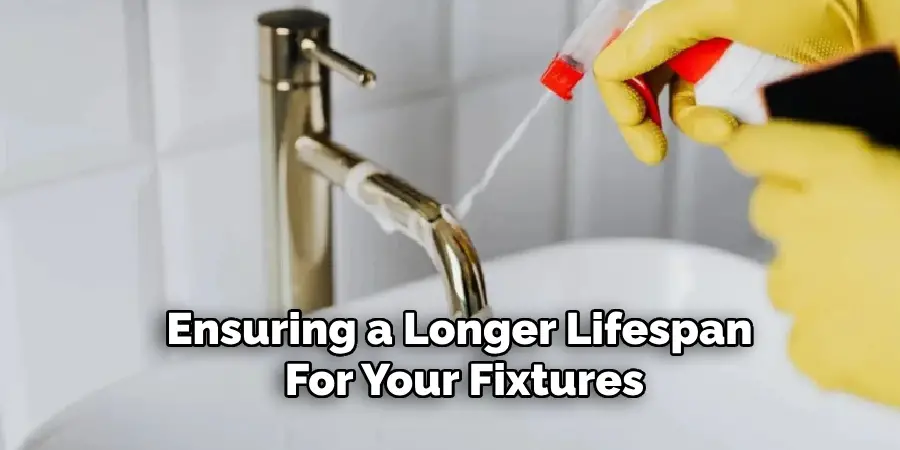
Preventing Limescale Buildup
Regular Cleaning
Wipe down the faucet regularly with a dry cloth to prevent water spots and limescale buildup. After each use, take a moment to dry the faucet to minimize the amount of water left on its surface. This simple habit can significantly reduce the chances of limescale and other mineral deposits forming, keeping your faucet gleaming and prolonging its life.
Water Softener
Consider installing a water softener to reduce the hardness of your water. Hard water, which contains high levels of calcium and magnesium, is the primary cause of limescale buildup. A water softener works by replacing these minerals with sodium ions, thus preventing them from accumulating on your fixtures. This not only helps in reducing limescale but also benefits your overall plumbing system and improves the efficiency of water-using appliances.
Vinegar Rinse
Periodically, use a vinegar solution to clean the faucet and prevent limescale from forming. Mix equal parts of white vinegar and water, and apply this solution to the faucet at least once a month. Let it sit for a few minutes before wiping it down with a soft cloth.
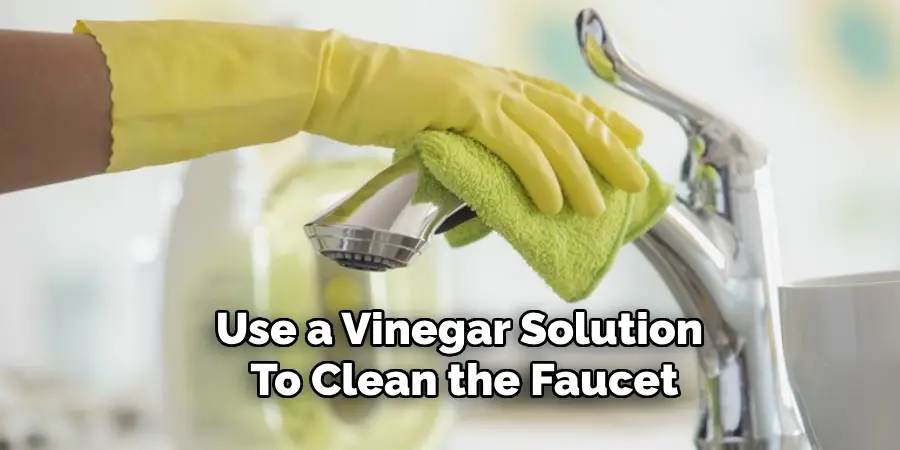
The mild acidity of vinegar will help dissolve any beginning stages of limescale, ensuring your faucet remains spotless and limescale-free.
FAQs About Limescale Removal and Prevention
What Causes Limescale Buildup on Faucets?
Limescale buildup is primarily caused by hard water, which contains high calcium and magnesium mineral concentrations. When hard water evaporates, it leaves behind these mineral deposits, forming limescale.
How Can I Tell if Limescale Is Affecting My Faucet?
Signs of limescale buildup include white or chalky deposits on the faucet’s surface, reduced water flow, and clogged aerators. Over time, limescale can cause the faucet to look dull and affect its functionality.
Are Natural Cleaning Methods as Effective as Commercial Products?
Natural cleaning methods, such as using vinegar, lemon juice, or baking soda, can be very effective for light to moderate limescale buildup and are environmentally friendly. However, commercial products specifically formulated for limescale removal may provide faster and more thorough results for stubborn or extensive limescale deposits.
Is It Safe to Use Vinegar and Lemon Juice on All Types of Faucets?
While vinegar and lemon juice are generally safe for most types of faucets, it’s important to avoid prolonged exposure, especially on faucets with delicate finishes like brass, gold, or nickel. Always rinse thoroughly and dry the faucet after using acidic cleaners to prevent potential damage.
How Often Should I Clean My Faucet to Prevent Limescale?
To prevent limescale buildup, wiping down your faucet with a dry cloth after each use is advisable. Additionally, performing a deeper clean with natural solutions like vinegar or lemon juice once a month can help maintain a limescale-free faucet.
Can a Water Softener Eliminate Limescale Completely?
A water softener can significantly reduce the hardness of your water, thereby minimizing limescale buildup. While it may not completely eliminate limescale, it can greatly reduce the frequency and severity of deposits, making cleaning and maintenance easier.
What if The Limescale Buildup Is Inside the Faucet?
Suppose limescale is affecting the internal parts of your faucet, such as the aerator or cartridge. In that case, you may need to disassemble these components and soak them in a limescale remover solution.

For persistent issues, consider consulting a plumbing professional for advice or repairs.
Conclusion
Eliminating limescale from a faucet can be achieved through both natural and commercial methods. Natural solutions like vinegar, lemon juice, and baking soda are effective and eco-friendly options for tackling limescale buildup. On the other hand, commercial limescale removers are designed for efficiency and can offer rapid results with minimal effort.
Regular maintenance is crucial to prevent limescale buildup, ensuring the longevity and aesthetic appeal of your faucets. Integrating simple steps such as drying your faucet after every use, performing periodic vinegar rinses, and considering a water softener can significantly reduce limescale formation.
Establishing a consistent cleaning routine not only keeps your faucets looking new but also promotes a healthier plumbing system. By understanding “how to get rid of limescale on faucet” and implementing these tips, you can effortlessly maintain the cleanliness and functionality of your fixtures.

